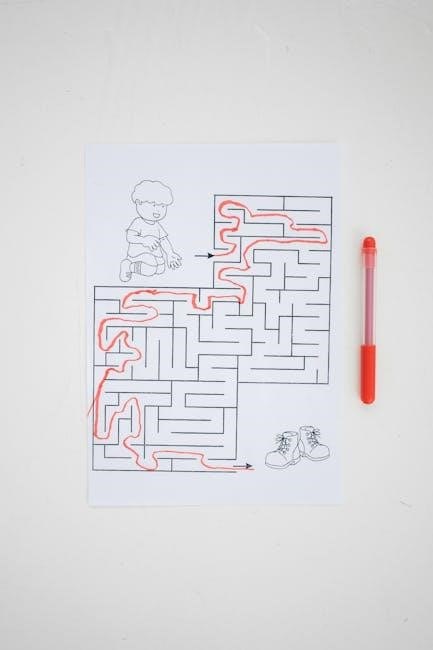Understanding the Root Causes of Self-Sabotage
Self-sabotage often stems from deep-seated insecurities, fear of failure, or past traumas. It can manifest as seeking external validation, negative self-talk, or people-pleasing, hindering personal growth and relationships.
1.1 Seeking External Validation
Seeking external validation is a common root cause of self-sabotage. Many individuals place their self-worth in the hands of others, believing their value depends on approval or acceptance. This pattern often stems from fear of not being “enough” or past experiences where love and validation were conditional. When we rely on others to define our worth, we lose touch with our inner needs and desires, leading to self-destructive behaviors like people-pleasing or overcomplicating relationships. This cycle can cause emotional exhaustion and dissatisfaction, as external validation is fleeting and often unfulfilling. Recognizing this pattern is the first step toward breaking free. By shifting focus inward and cultivating self-acceptance, individuals can reduce the need for external approval, fostering healthier relationships and personal growth. This mindset is crucial for healing and stopping the cycle of self-sabotage, as emphasized in Meggan Roxanne’s insights on self-love and boundaries.

Strategies to Stop Breaking Your Own Heart
Stop people-pleasing, set boundaries, and prioritize self-care. Unfollow toxic influences, manage expectations, and recognize negative thought patterns. Embrace self-compassion, intentional living, and surround yourself with positivity to heal and grow.
2.1 Unfollow and Distance from Toxic Influences
Unfollowing and distancing from toxic influences is a powerful step toward healing. Often, people or accounts on social media can trigger negative emotions, fostering self-doubt and self-sabotage. By curating your digital space, you reduce exposure to harmful content that drains your energy. This includes unfriending or muting individuals who spread negativity or make you feel inadequate. Surrounding yourself with uplifting influences helps cultivate a positive mindset. Recognize that external validation should not dictate your self-worth. Instead, focus on building a support system that uplifts and inspires you. This intentional shift allows you to break free from cycles of comparison and self-criticism, fostering a healthier relationship with yourself and others; Remember, your mental well-being is worth prioritizing.
2.2 Evaluate and Set Boundaries in Relationships
Evaluating and setting boundaries in relationships is crucial to prevent self-sabotage. Toxic relationships often stem from a lack of clear limits, leading to emotional drain and resentment. Start by identifying patterns where others may be crossing your emotional or mental boundaries. Communicate your needs assertively, ensuring your voice is heard without aggression. Healthy boundaries are not about controlling others but protecting your own well-being. Surround yourself with people who respect and honor these limits. Remember, setting boundaries is an act of self-love and respect, fostering healthier, more balanced relationships. By prioritizing your emotional safety, you create space for growth and reduce the risk of self-sabotaging behaviors. This step is essential for breaking the cycle of people-pleasing and reclaiming your power in relationships.
2.3 Manage Expectations to Reduce Disappointment
Managing expectations is a powerful way to reduce disappointment and prevent self-sabotage. Often, we set unrealistic standards for ourselves or others, leading to emotional pain when these are not met. Recognize that no one, including yourself, is perfect. Challenge negative thought patterns that fuel these expectations, such as believing others must behave in specific ways to validate your worth. Instead, focus on what you can control and accept that life is unpredictable. Align your expectations with reality, understanding that people and circumstances will not always meet your ideals. By letting go of rigid expectations, you create space for acceptance and reduce the likelihood of self-sabotaging behaviors triggered by disappointment. This mindset shift fosters resilience and allows you to navigate life’s challenges with greater emotional balance.
2.4 Recognize and Interrupt Negative Thought Spirals
Negative thought spirals are a common trap that fuels self-sabotage. These are patterns of thoughts that spiral downward, amplifying feelings of inadequacy or hopelessness. Recognizing these cycles is the first step to interrupting them. Often, they begin with self-criticism or fears of failure, escalating into overwhelming emotional turmoil. To break this cycle, practice mindfulness to catch these thoughts early. Challenge their validity by asking if they are based in reality or fueled by past wounds. Replace negative self-talk with compassionate, affirming statements. Grounding techniques, such as deep breathing or journaling, can also help shift focus away from toxic mental loops. Interrupting these spirals requires consistent effort but is essential for fostering emotional resilience and stopping self-sabotaging behaviors. By doing so, you create space for healthier thought patterns and a more balanced mindset.
2.5 Practice Self-Compassion and Mindfulness
Practicing self-compassion and mindfulness is essential for breaking the cycle of self-sabotage. Self-compassion involves treating yourself with kindness, understanding, and patience, especially during difficult moments. Mindfulness helps you stay present, observe your thoughts without judgment, and respond rather than react. Start by incorporating grounding routines like meditation, journaling, or deep breathing to calm your mind. Acknowledge your emotions without criticizing yourself, and remind yourself that it’s okay to make mistakes. Replace self-criticism with affirming statements that promote self-worth. Mindfulness practices, such as focusing on sensory experiences or mindful movement, can also improve mental clarity and emotional balance. By fostering a compassionate relationship with yourself, you create a foundation for healing and growth, allowing you to break free from patterns of self-sabotage and embrace a more fulfilling life.

2.6 Embrace Intentional Living
Embracing intentional living is a powerful way to break free from self-sabotage. It involves living with purpose, clarity, and alignment with your values. Start by setting clear goals and priorities, ensuring your actions reflect what truly matters to you. Intentional living encourages mindfulness, helping you stay focused on the present and avoid distractions that derail your progress. Practice grounding routines, such as meditation or journaling, to cultivate awareness and direction. By living intentionally, you regain control over your choices and decisions, fostering a sense of purpose and fulfillment; This mindset shifts your focus from external validation to internal satisfaction, empowering you to create a life that honors your true self and supports lasting growth.
2.7 Heal from Past Wounds
Healing from past wounds is essential to breaking the cycle of self-sabotage. Unresolved pain often leads to destructive patterns, as individuals subconsciously recreate familiar, albeit harmful, experiences. Acknowledge these wounds and confront the emotions tied to them, rather than suppressing or denying them. Seek support through therapy, trusted friends, or support groups to process these experiences. Journaling or reflective practices can also help uncover and release buried emotions. Remember, healing is not about erasing the past but integrating its lessons into your present. By addressing these wounds, you diminish their power over your choices, allowing you to move forward with greater resilience and self-awareness. This step is crucial for rebuilding self-trust and fostering healthier relationships with yourself and others.

2.8 Build Self-Awareness
Building self-awareness is a cornerstone of overcoming self-sabotage. It involves understanding your thoughts, emotions, and behaviors, particularly those rooted in past experiences. Start by journaling or practicing mindfulness to identify patterns that lead to self-sabotaging actions. Recognize how external validation or fear of failure may drive your decisions. Self-awareness helps you pause before reacting impulsively, allowing you to choose responses that align with your values. It also enables you to notice when negative self-talk or unrealistic expectations are at play. By gaining clarity on your triggers and emotional responses, you can address them constructively. This heightened awareness empowers you to break free from cycles of self-destruction and make intentional choices that nurture your growth and well-being.

2.9 Surround Yourself with Positive Influences
Surrounding yourself with positive influences is a powerful way to break the cycle of self-sabotage. Negative relationships or environments can fuel self-doubt and destructive behaviors, making it harder to heal. Instead, seek out people who uplift and support you, fostering a sense of belonging and worth. Unfollow or distance yourself from social media accounts that trigger insecurity or negativity. Invest in relationships where you feel valued and encouraged. Positive influences can inspire growth, offer constructive feedback, and remind you of your potential. Additionally, immerse yourself in uplifting content, such as motivational books, podcasts, or affirmations, to reinforce self-love and confidence. By curating a supportive environment, you create space for healing and empowerment, helping you move away from self-sabotaging patterns and toward a life of intention and fulfillment.
2.10 Take Action Towards Personal Goals
Taking action toward personal goals is a transformative step in overcoming self-sabotage. When you remain stagnant, it’s easy to fall into cycles of doubt and negativity. Setting and pursuing meaningful objectives helps rebuild confidence and creates a sense of purpose. Start by identifying what truly matters to you and break your goals into small, achievable steps. Celebrate each milestone, no matter how minor, to build momentum and reinforce self-belief. Action breeds clarity and motivation, helping you move beyond fear and self-doubt. By focusing on progress rather than perfection, you empower yourself to take control of your life. Remember, growth happens outside your comfort zone, and consistent effort leads to lasting change. Taking deliberate steps toward your goals fosters resilience and helps you break free from patterns of self-sabotage, paving the way for a more fulfilling and intentional life.
2.11 Engage in Self-Care
Engaging in self-care is essential for healing and stopping self-sabotage. It involves nurturing your physical, emotional, and mental well-being through intentional practices. Start by incorporating activities that bring you joy and relaxation, such as meditation, journaling, or spending time in nature. Prioritize rest and ensure you’re getting enough sleep, as a tired mind and body are more susceptible to negative patterns. Healthy eating and exercise also play a role in boosting your mood and energy levels. Self-care isn’t just about pampering; it’s about creating a routine that shows you value yourself. By making self-care a non-negotiable part of your daily life, you build resilience and reduce the tendency to self-sabotage. Remember, caring for yourself is an act of love and respect, and it’s the foundation for living a life where you no longer break your own heart.
2.12 Create a Support System
Creating a support system is crucial for overcoming self-sabotage and healing your heart. Surround yourself with people who uplift and encourage you, and avoid those who drain your energy or trigger negative patterns. A strong support system provides emotional safety, allowing you to feel seen and valued. Seek out friends, family, or mentors who align with your values and goals. Additionally, consider joining communities or groups where you can connect with others on similar journeys of self-growth. Professional support, such as therapy or counseling, can also be a vital part of your network. By building a web of positive influences, you create a foundation that helps you stay grounded and motivated. Remember, you don’t have to heal alone—leaning on others is a sign of strength, not weakness. A supportive network can help you navigate challenges and celebrate your progress along the way.
2.13 Celebrate Progress
Celebrating progress is a powerful way to build confidence and stay motivated on your journey to stop breaking your own heart. Acknowledge even the smallest victories, as they add up over time. Recognizing your growth helps reinforce positive habits and encourages continued effort. Whether it’s setting boundaries, practicing self-care, or simply showing up for yourself, celebrate these milestones. Gratitude for how far you’ve come strengthens your commitment to healing. It’s easy to focus on what’s still ahead, but progress, no matter how small, is worth honoring. By celebrating your wins, you create a mindset of encouragement and self-compassion. This practice helps you stay resilient and reminds you that every step forward is a testament to your strength and dedication. Celebrating progress isn’t just about achievements—it’s about embracing the journey and nurturing your inner growth.
Breaking free from self-sabotage is a journey requiring patience, self-compassion, and intentional choices. By addressing root causes and implementing strategies, you can heal and build a fulfilling life rooted in self-love.
3.1 Embrace Patience and Compassion in Healing
Healing from self-sabotage requires patience and compassion; Recognize that growth is gradual, and setbacks are part of the journey. Treat yourself with kindness, understanding that breaking cycles takes time. Avoid harsh self-judgment, as it perpetuates harm. Instead, foster a nurturing mindset, allowing yourself space to heal. Compassion helps rewire negative patterns, replacing self-criticism with acceptance. Patience enables persistence, even when progress feels slow. By embracing these qualities, you create a safe environment for transformation, empowering yourself to move beyond self-sabotage and toward a life of self-love and fulfillment. Remember, healing is not a linear process but a journey of gentle, consistent steps forward.

























































